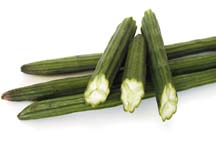
Eleanor Nakama-Mitsunaga

|
This pod-like vegetable looks like okra on steroids, although it can be harvested much younger, when just about a couple of centimeters long. It is used in soups, stews and stir-fries in the Philippines, Guam and throughout the Pacific.The basics: Most commonly known here by the Filipino name malungay or malunggay, these pods come from a tree also known as moringa, horseradish or drumstick tree. The tree is native to India, but is widely grown throughout the Pacific, Africa, Indonesia and South and Central America. Its leaves, flowers and pods are all edible and traditionally have been used for medicinal purposes as well.
The roots are used as a spice similar to horseradish. The pods -- green, turning brown when mature -- house pea-like seeds encased in white flesh. The flavor of the pods has been compared to asparagus. The tender leaves are also used in the same manner as spinach. They are delicate and are unusually teardrop-shaped. Both the leaves and pods are a good source of calcium, iron and vitamins A, B and C.
Selecting: If cooking whole, look for small, younger pods. Make sure they are green and watch out for those with blemishes and brown spots. The leaves are highly perishable and are sold freshly harvested in bunches.
Storing: Pods may be kept in the refrigerator for a couple of days. Use leaves immediately.
Use: Young pods can be eaten whole and are often parboiled or steamed first, then sautéed or added to soups and stews. With older pods, the outer skin should be removed to leave only the inner seeds and flesh. Cut into the pod, but not all the way. Break open the pod and scrape out the flesh and seeds. Rinse to remove the sticky film or blanch for a few minutes. The flesh and peas can then be used in soups or stews.
Malungay leaves, removed from the woody stems, can be used raw in salads or sautéed with chicken, ginger, garlic, onion and green papaya.
Where to buy: Malungay greens and pods are available year-round, but sporadically. Farmers markets, Chinatown or Asian markets that carry Filipino ingredients are the best sources. Prices running from $1 for a bunch of greens to $1 to $2 a pound for the pods.
Eleanor Nakama-Mitsunaga is
a free-lance food writer. Contact her
online through features@starbulletin.com

